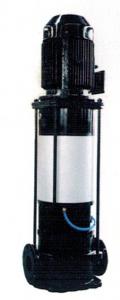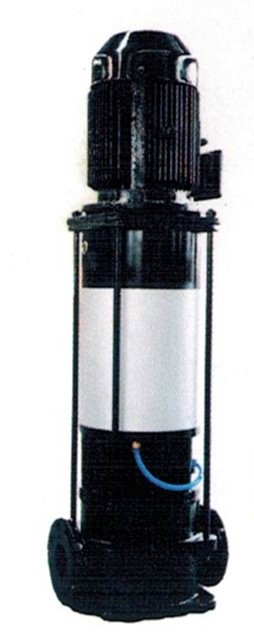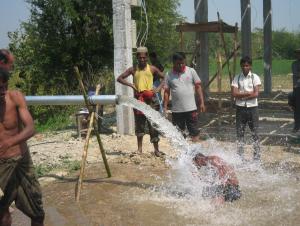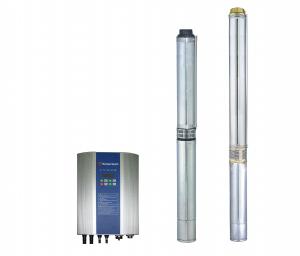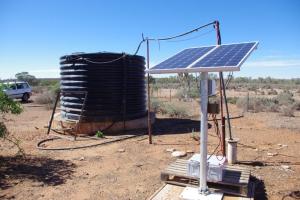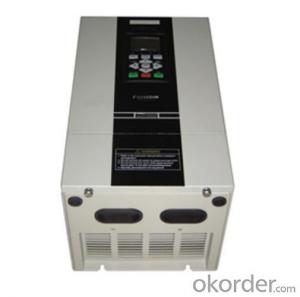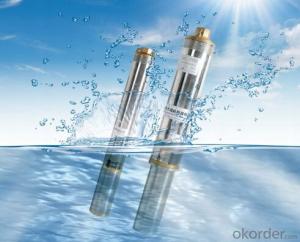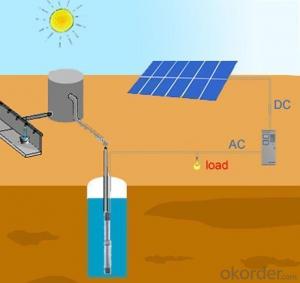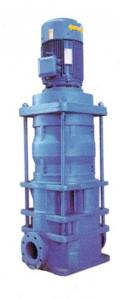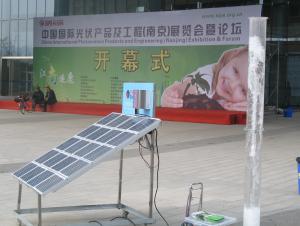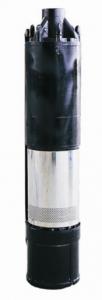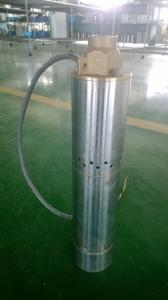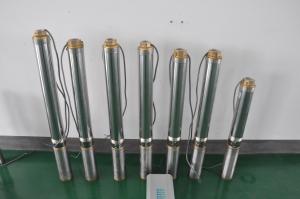Aquajet Solar Water Pump L3D-20-80
- Loading Port:
- China Main Port
- Payment Terms:
- TT OR LC
- Min Order Qty:
- -
- Supply Capability:
- 300 sets /month
OKorder Service Pledge
OKorder Financial Service
You Might Also Like
Product description:
Product: Solar water pump
Model:L3D-20-80
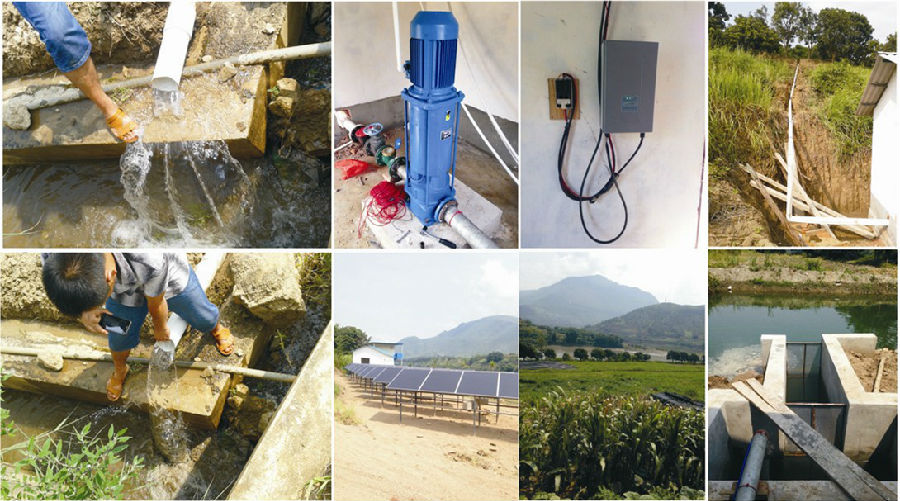
Appilication:
surface pump
for surface water of pond, river, lake
for irrigation of a big farm with 12000 m2 on the top of a small hill
Product specification:
flow rate:20m3/ hour, 160m3/day.
lift: 10m-80m
pump diameter: 296mm
Pump installed on the ground, outlet to the water surface:4m
with AC motor, motor power:5.5kW
but only need solar power:3.2kW(while Grundfos pump needs at least 11.5kW solar power, our pump can save more than 50% solar panel power,save USD3600 cost for solar panel per set.
Material:
Pump inside: stainless steel and wearable nylon,it enables our solar pump to have 10 years sevice life.
Motor : AC motor, 380V , three phase , 50Hz. The pump also can connect with grid power directly.
Certification:
3 International patent
ISO9001
CE
Warranty:2 years
- Q: How do I calculate the solar energy required for running a solar pump?
- To determine the solar energy needed to operate a solar pump, several factors must be taken into account: 1. Find out the power consumption of the pump by checking its wattage rating. This information is typically available in the pump's specifications or user manual. 2. Estimate the daily energy usage by multiplying the pump's power rating by the number of hours it operates each day. For instance, if the pump has a rating of 500W and runs for 4 hours, the daily energy consumption would be 500W x 4 hours = 2000 watt-hours (Wh) or 2 kilowatt-hours (kWh). 3. Consider efficiency losses since solar panels are not 100% efficient. It is generally assumed that solar panels have an efficiency of 70-80%. To account for this, divide the daily energy consumption (calculated in step 2) by the assumed panel efficiency. For example, if the daily energy consumption is 2 kWh and the assumed panel efficiency is 75%, the required solar energy would be 2 kWh / 0.75 = 2.67 kWh. 4. Take into account solar insolation, which refers to the amount of solar radiation received per unit area in a specific timeframe. Solar insolation varies based on location and time of year. Use local weather data or conduct research to determine the average daily solar insolation for your area. This information is typically given in kilowatt-hours per square meter per day (kWh/m²/day). 5. Calculate the necessary solar panel capacity by dividing the required solar energy (from step 3) by the average daily solar insolation (from step 4). For instance, if the required solar energy is 2.67 kWh and the average daily solar insolation is 5 kWh/m²/day, the required solar panel capacity would be 2.67 kWh / 5 kWh/m²/day = 0.534 square meters (or 534 square centimeters). Bear in mind that this calculation provides an estimate, and actual results may vary due to factors like shading, panel orientation, and efficiency variations. It is advisable to consult a solar energy professional or supplier for a more accurate assessment tailored to your specific needs.
- Q: Can a solar pump be used for residential fountain installations?
- Indeed, residential fountain installations can certainly make use of a solar pump. For homeowners seeking to power their fountain without depending on conventional electricity sources, solar pumps present a remarkable solution. These pumps harness solar energy from the sun to energize the motor, which subsequently drives water circulation and creates the desired fountain effect. Not only are they environmentally friendly, but they also prove to be cost-effective in the long run by eliminating the need for electricity consumption. Thanks to advancements in solar technology, solar pumps have experienced increased efficiency and reliability, rendering them a favored option for residential fountain installations. Furthermore, they boast easy installation and minimal maintenance requirements, making them a convenient choice for homeowners. Therefore, if you are contemplating the installation of a fountain on your residential property, a solar pump can be an excellent decision.
- Q: Can a solar pump be used for water supply in remote eco-lodges?
- Yes, a solar pump can be used for water supply in remote eco-lodges. Solar pumps are efficient and environmentally friendly, making them ideal for off-grid locations like eco-lodges. They can reliably extract and distribute water from wells, rivers, or other water sources, providing a sustainable and independent water supply solution for remote areas.
- Q: Can a solar pump be used in remote areas with no access to electricity?
- Yes, a solar pump can be used in remote areas with no access to electricity. Solar pumps are designed to operate using solar energy, which means they can function independently without the need for a power grid or electricity connection. This makes them an ideal solution for providing water in off-grid or remote locations where electricity is not available.
- Q: Can a solar pump be used for hydroponic farming systems?
- Yes, a solar pump can be used for hydroponic farming systems. Solar pumps are an environmentally friendly and cost-effective solution for providing water circulation and nutrient delivery in hydroponic systems. They can effectively power the necessary water flow and can be easily integrated into the overall setup.
- Q: Can a solar pump be used for industrial purposes?
- Yes, a solar pump can be used for industrial purposes. Solar pumps are increasingly being used in various industrial applications such as agriculture, manufacturing, mining, and water treatment. These pumps are powered by solar energy, which makes them environmentally friendly and cost-effective in the long run. Solar pumps are capable of delivering high flow rates and pressures, making them suitable for industrial operations that require water supply, irrigation, or fluid transfer. They can be used for pumping water from wells, rivers, lakes, or reservoirs, and can also be integrated into existing water systems or networks. One of the key advantages of using a solar pump for industrial purposes is the potential for significant cost savings. Solar energy is a renewable resource, and once the initial installation costs are covered, the ongoing operational expenses are minimal. This makes solar pumps a reliable and cost-effective solution, particularly in remote or off-grid locations where traditional electricity supply may not be available or affordable. Furthermore, solar pumps are often equipped with advanced technologies and monitoring systems that optimize their performance and ensure efficient water management. These pumps can be automated, allowing for remote control and monitoring, which is especially useful in industrial settings where continuous operation and precise water supply are crucial. In summary, a solar pump can indeed be used for industrial purposes. Its ability to harness solar energy, cost-effectiveness, and reliability make it a sustainable and viable option for industrial operations that require water supply, irrigation, or fluid transfer.
- Q: How does a solar pump handle water source contamination from radioactive materials?
- A solar pump does not directly address the issue of water source contamination from radioactive materials. It is primarily designed to harness solar energy to pump water, but it does not have specific mechanisms to filter or treat water contaminated with radioactive materials. In such cases, additional water treatment systems or methods would be required to ensure the removal or reduction of radioactive contaminants before the water can be considered safe for use.
- Q: Are there any limitations on the temperature range that solar pumps can operate in?
- Yes, there are limitations on the temperature range that solar pumps can operate in. Solar pumps are designed to work in specific temperature ranges, typically between -40°C to 60°C (-40°F to 140°F). Extreme temperatures outside of this range can negatively impact the performance and efficiency of solar pumps.
- Q: Can a solar pump be used in industrial applications?
- Indeed, industrial applications can make use of a solar pump. A solar pump finds utility in diverse industrial domains such as water supply, irrigation, wastewater treatment, and even the oil and gas industry. Particularly in remote regions where electricity access is scarce or costly, solar pumps prove invaluable. Their affordability, eco-friendliness, and minimal maintenance demands make them an attractive choice. Moreover, they can be seamlessly integrated with other renewable energy systems like solar panels or wind turbines, ensuring a dependable and sustainable power source for industrial purposes. In summary, solar pumps present a practical resolution for industrial water pumping needs while decreasing dependence on fossil fuels.
- Q: Can a solar pump be used for water supply in remote villages?
- Yes, a solar pump can be used for water supply in remote villages. Solar pumps are a sustainable and cost-effective solution for providing water in areas where there is no access to electricity. They rely on solar energy to power the pump, which means they can operate independently and reliably in remote locations. Additionally, solar pumps require minimal maintenance and have a long lifespan, making them suitable for sustainable water supply in remote villages.
Send your message to us
Aquajet Solar Water Pump L3D-20-80
- Loading Port:
- China Main Port
- Payment Terms:
- TT OR LC
- Min Order Qty:
- -
- Supply Capability:
- 300 sets /month
OKorder Service Pledge
OKorder Financial Service
Similar products
Hot products
Hot Searches
Related keywords
